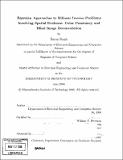Bayesian approaches to bilinear inverse problems involving spatial evidence : color constancy and blind image deconvolution
Author(s)
Singh, Barun, 1982-
DownloadFull printable version (10.32Mb)
Other Contributors
Massachusetts Institute of Technology. Dept. of Electrical Engineering and Computer Science.
Advisor
William T. Freeman.
Terms of use
Metadata
Show full item recordAbstract
This thesis examines two distinct but related problems in low-level computer vision: color constancy and blind-image deconvolution. The goal of the former is to separate the effect of global illumination from other properties of an observed image, in order to reproduce the effect of observing a scene under purely white light. For the latter, we consider the specific instance of deblurring, in which we seek to separate the effect of blur caused by camera motion from all other image properties in order to produce a sharp image from a blurry one. Both problems share the common characteristic of being bilinear inverse problems, meaning we wish to invert the effects of two variables confounded by a bilinear relationship, and of being underconstrained, meaning there are more unknown parameters than known values. We examine both problems in a Bayesian framework, utilizing real-world statistics to perform our estimation. We also examine the role of spatial evidence as a source of information in solving both problems. The resulting blind image deconvolution algorithm produces state-of-the art results. The color constancy algorithm produces slightly improved results over the standard Bayesian approach when spatial information is used. We discuss the properties of and distinctions between the two problems and the solution strategies employed.
Description
Thesis (S.M.)--Massachusetts Institute of Technology, Dept. of Electrical Engineering and Computer Science, 2006. Includes bibliographical references (p. 85-89).
Date issued
2006Department
Massachusetts Institute of Technology. Department of Electrical Engineering and Computer SciencePublisher
Massachusetts Institute of Technology
Keywords
Electrical Engineering and Computer Science.